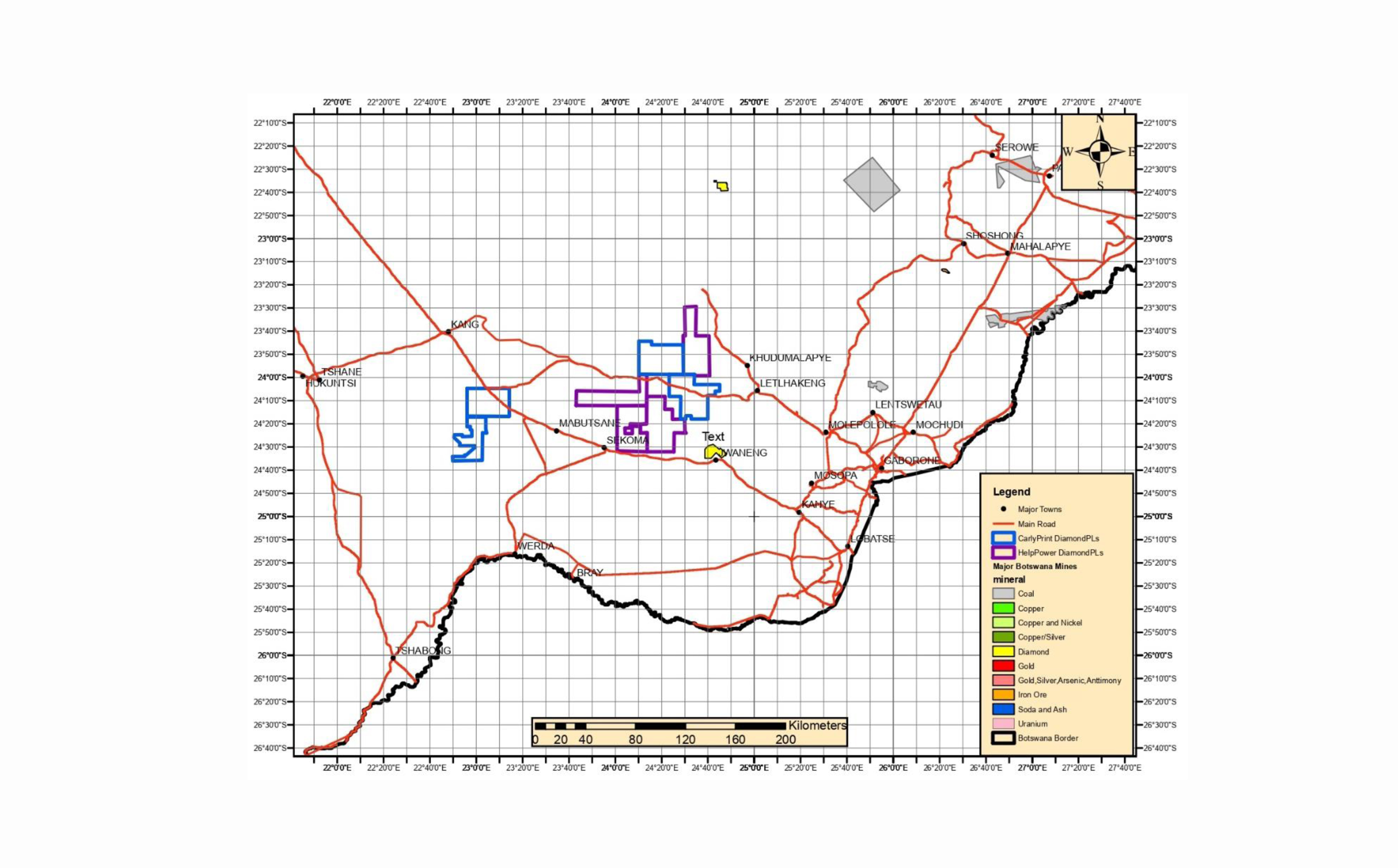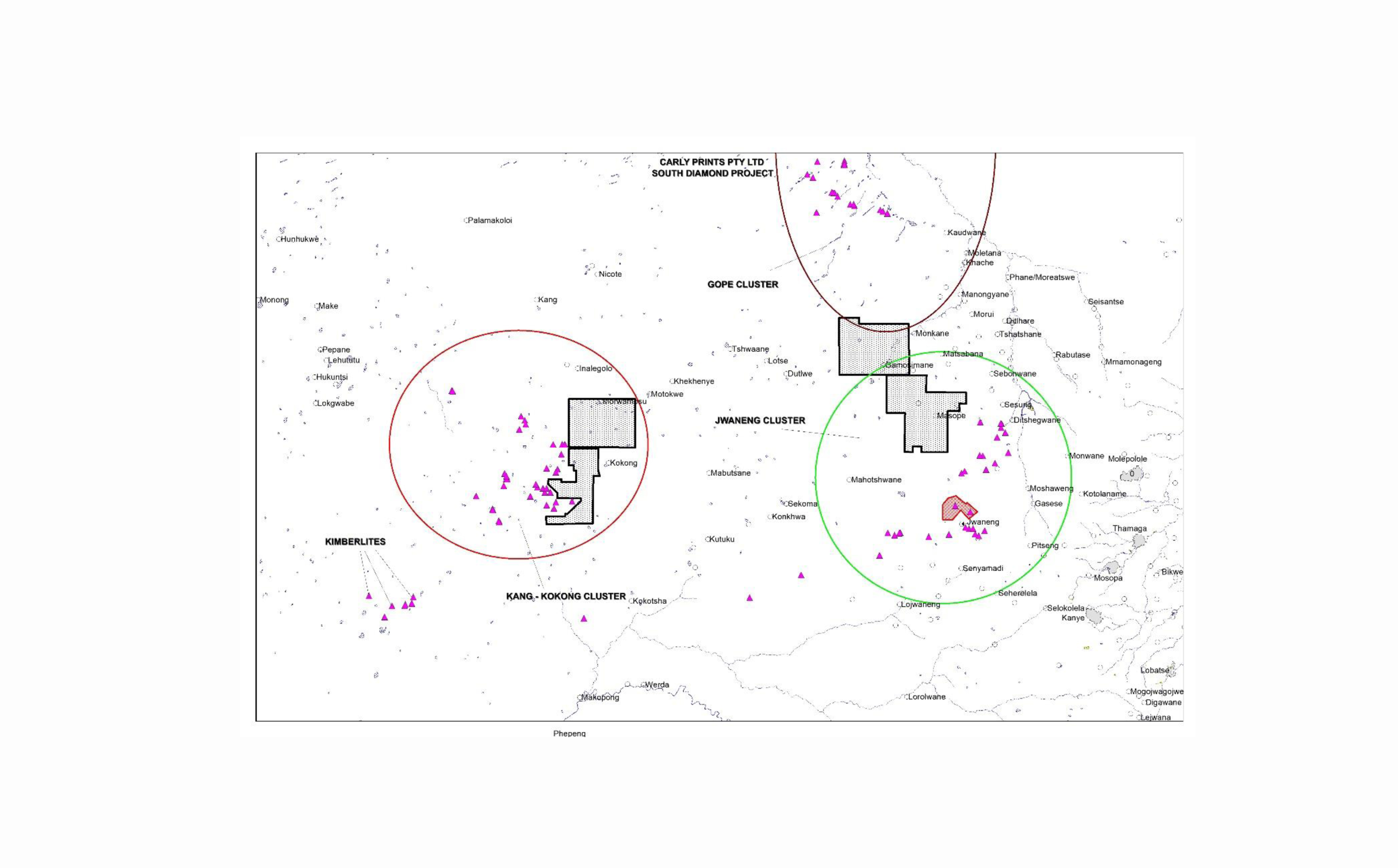2. DIAMOND EXPLORATION PROSPECTING LICENCES:
The Opportunity:
-
2789.2 km2 of greenfields to brownfields exploration tenure on the unexplored part of
the highly prospective kang and Jwaneng cluster.
Prospective area partially covered by shallow sediments
The country major explorer has returned into exploration industry in the region.
Clear and well-defined geophysical anomalies.
Sound geological information to support increased exploration activities in the area.
Stable & positive investments country with mining friendly government & legislature.
Tenure is privately held with strong upside for early entry.
Project Location:
Carly Prints (Pty) was granted four Diamond Prospecting Licence (PL096/2020, PL097 /
2020, PL098/2020 and PL099/2020), hereafter referred as the south project area, for an
initial period of three years from the 1st July 2020 to 31st June 2023. The initial area of
the south Diamond Prospecting Licence is 2789.2 km2.
The exploration objective of Carly Prints Pty Ltd can be simplified by stating that it is to
find an economically viable kimberlite sourcecontaining diamonds in the Kang area. The
strategy is driven and managed by Carly Prints Consultants who have experience in
carrying out similar projects & have sufficient geological mapping knowledge, kimberlite
exploration competence, and will rely on other expertise available in southernAfrica for
kimberlite evaluation, due diligence and mineral resource review. The South project area
is located west of Kokong Village and north of the world class Jwaneng Diamond
(Figure 1).
Kimberlite:
The South project area is surrounded by the following kimberlite clusters (Figure 2):
-
The off craton Okwa kimberlite cluster is located about 150 km north-westof the Kang-Kokong project
area and has yielded one Rb-Sr mica age of 87± 7 Ma.
The Khutse-Kikao / Gope kimberlite clusters are located about 175 - 260 km north-east of the Kang Kokong project areaand has yielded U-Th-Pb zircon age of 84 ± 2 Ma that and two Rb-Sr mica ages of 85 ± Ma and 87 ± 7Ma. The newly discovered KX36 kimberlite (Sekaka Diamons) is located about 275 km northeast of the CBS Kang-Kokong area.
The Jwaneng kimberlite cluster has yielded numerous U-Th-Pb zircon ages of between 232–235 Ma obtained from U-Pb SHRIMP ages is located about 185–225km south=east of CBS Kang-Kokong area.
The Jwaneng & Ditshegwane kimberlites cluster has yielded numerous U-ThPb zircon ages of between 232–235 Ma obtained from U-Pb SHRIMP ages is located about 185–225 km south=east of CBS Kang-Kokong area.
The Cretaceous aged Tshabong, Kang-Kokong and Orapa kimberlite have yielded U-Pb zircon ages of 85 ± 5 Ma.
Exploration History Over Kang-Kokong Area
Different exploration companies have undertaken diamond exploration in the South project area since
the early 1970s utilising mainly regional reconnaissance soil sampling for kimberlitic indicator minerals
accompanied by limited ground geophysical surveying initially. The Kang-Kokong kimberlite field (cluster)
was discovered in the 1970’s through sampling of magnetic work completed by De Beers & Falconbridge.
By 1993, 30 kimberlites had been discovered in the Kang-Kokong area.
A number of airborne magnetic
anomalies and indicator mineral anomalies still had to be tested after 1993. During this time a number of
companies applied for the ground to further explore for kimberlites located in cluster perceived to be
underexplored at that time. De Beers and Falconbriedge were the pioneers of diamond exploration in the
area and were later followed by Southern Africa Minerals Corporation, Layfield Resources Incorporation,
AfriOre, Billiton Limited, Sekaka Diamonds, Pioneer Mining Company (Trivalence Mining Company) and
Rio Tinto Mining and Exploration.


